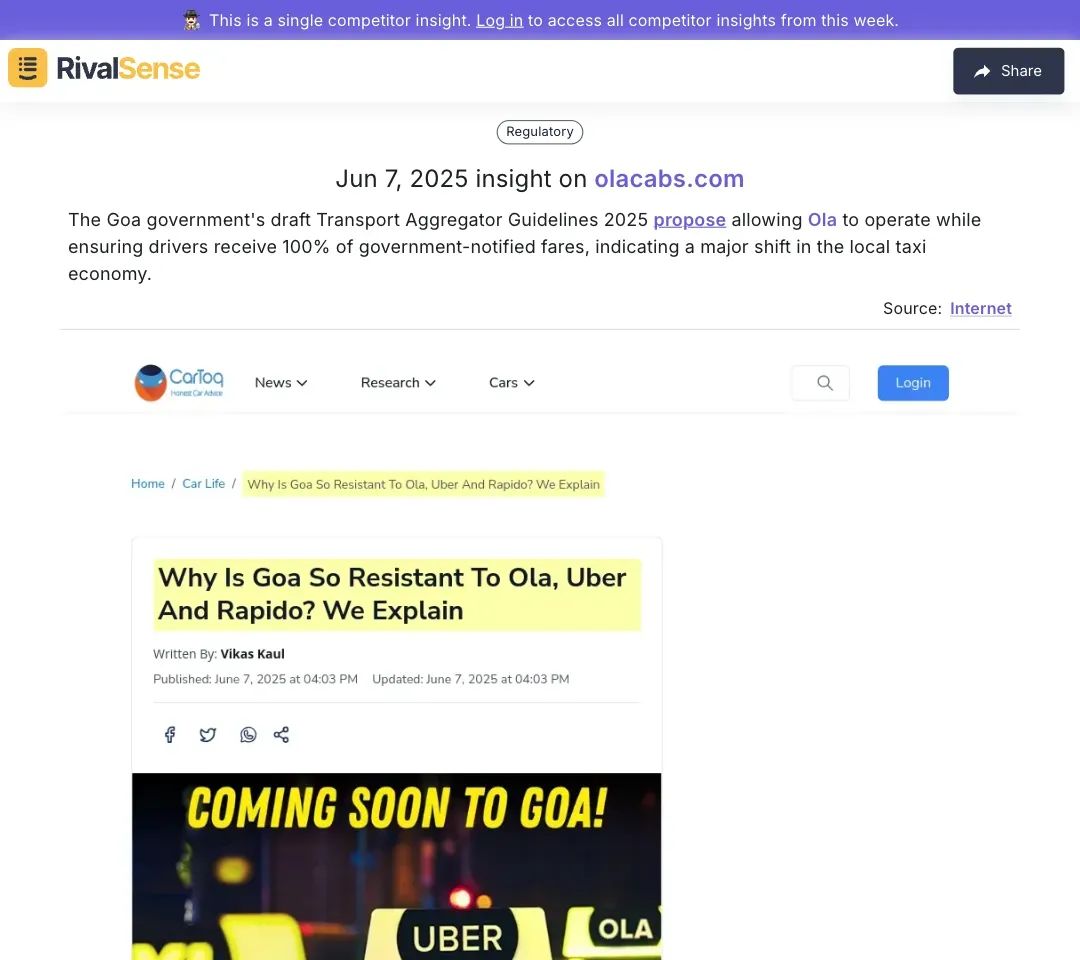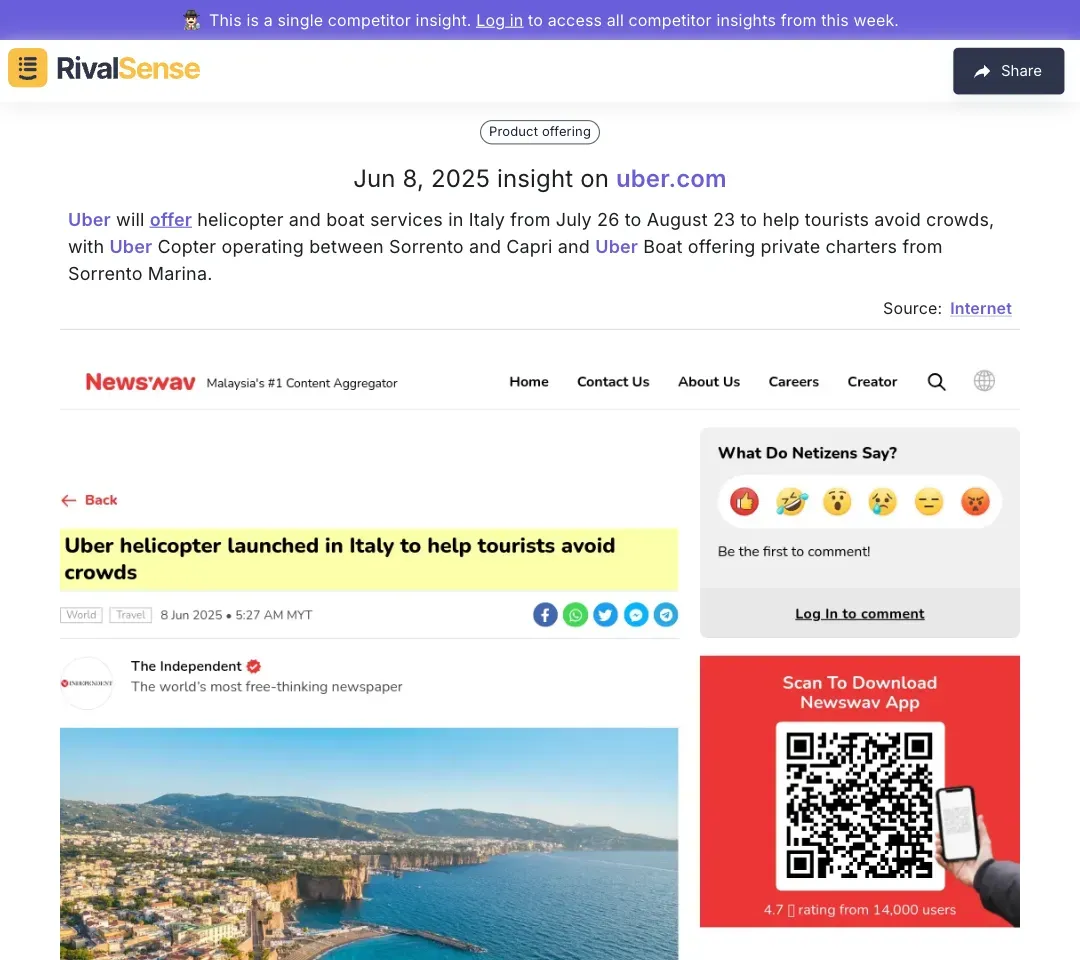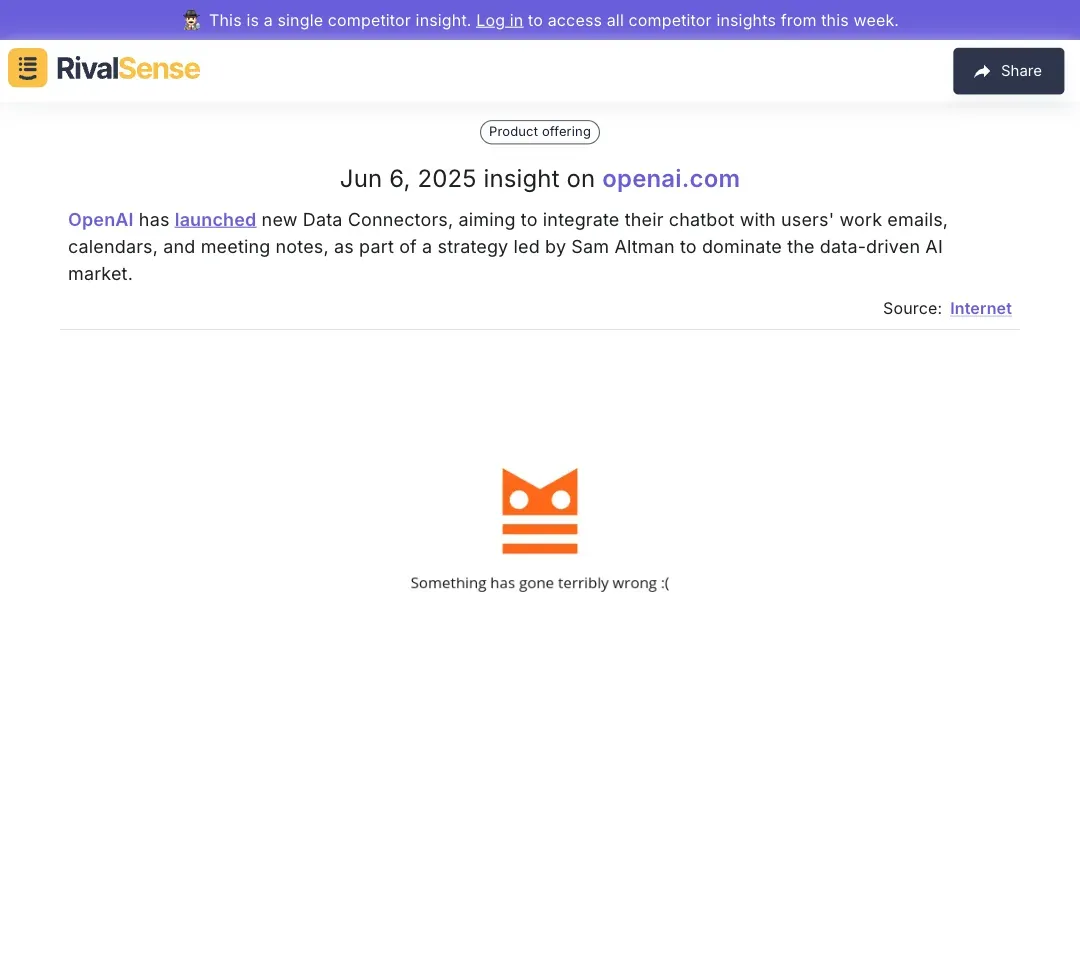Step-by-Step Guide to Strategic AR/VR Competitive Research
In the rapidly evolving AR/VR industry, competitive research isn't just beneficial—it's essential for survival. Understanding competitors' strategies, strengths, and weaknesses allows you to identify market gaps, innovate effectively, and position your business for success. AR/VR is transforming industries through immersive customer experiences, enhanced training programs, and revolutionary product demonstrations. To maintain a competitive edge, leverage intelligence across multiple dimensions including regulatory shifts that could impact your market position.
For example, consider how tracking regulatory changes creates strategic advantages:

RivalSense Insight: The Goa government's draft Transport Aggregator Guidelines 2025 propose allowing Ola to operate while ensuring drivers receive 100% of government-notified fares. Monitoring such regulatory shifts helps anticipate market disruptions and adjust business models proactively.
Actionable Framework:
- 🔍 Identify Key Competitors: List companies leading in AR/VR within your niche
- ⚙️ Analyze Their Offerings: Examine products, pricing, and customer feedback patterns
- 📈 Monitor Market Trends: Track technological advancements and adoption rates
- 📣 Evaluate Marketing Strategies: Study content, social media, and engagement tactics
- 🤝 Assess Partnerships: Note strategic alliances affecting market dynamics
Pro Tip: Conduct quarterly competitive audits to adapt to AR/VR's fast-paced evolution.
Identifying Your AR/VR Competitors
Pinpointing relevant competitors forms the foundation of effective competitive intelligence. Without accurate competitor mapping, your research lacks direction and actionable context. Begin by categorizing competitors based on their market proximity and solution alignment.
- Direct vs. Indirect Competitors:
- Direct: Companies offering similar AR/VR solutions
- Indirect: Businesses solving same customer needs with different technologies
- Discovery Tools:
- Use Crunchbase for funding insights
- Leverage LinkedIn for organizational changes
- Implement automated tracking via platforms like RivalSense
- Positioning Analysis:
- Examine USPs through product demos
- Compare pricing models and target segments
- Analyze SEO strategies using SEMrush
Competitor Mapping Checklist:
- [ ] Catalog direct and indirect players
- [ ] Identify market entry timelines
- [ ] Document market share indicators
- [ ] Track executive movements
Practical Tip: Attend AR/VR conferences like AWE to spot emerging players before they dominate search results.
Analyzing Competitor Products and Offerings
Deep product analysis reveals innovation opportunities and feature gaps. Systematic evaluation of competitors' solutions provides benchmarks for your own development roadmap. Pay special attention to seasonal offerings and geographic expansions that indicate strategic pivots.

RivalSense Insight: Uber's launch of helicopter and boat services in Italy (July 26-August 23) demonstrates how tracking product expansions reveals new market opportunities. Such intelligence helps anticipate seasonal demand shifts.
Analysis Framework:
| Aspect | Your Solution | Competitor A | Competitor B |
|-----------------|---------------|--------------|--------------|
| Core Features | ✓✓✓ | ✓✓ | ✓✓✓ |
| Pricing Model | Subscription | Freemium | One-time |
| UX Rating | 4.5/5 | 3.8/5 | 4.2/5 |
| Unique Tech | Patent #X | None | AI integration|
Action Steps:
- Conduct feature gap analysis quarterly
- Monitor app store reviews for pain points
- Track patent filings in AR/VR domains
- Analyze bundling strategies during holiday seasons
Monitoring Competitor Marketing and Outreach
Marketing surveillance uncovers acquisition strategies and audience engagement tactics. Consistent monitoring helps benchmark your outreach effectiveness while revealing untapped channels. Focus on campaign patterns rather than isolated activities to identify strategic priorities.
Key Areas to Track:
- Campaign Channels: Social platforms, email sequences, webinar frequency
- Content Performance: Viral AR demos, tutorial engagement, dwell time
- Partnership Impact: Co-branded initiatives, influencer collaborations
Monitoring Toolkit:
- 📊 Google Analytics for traffic sources
- 🔔 RivalSense for campaign launch alerts
- 📱 Social listening tools (e.g., Hootsuite)
- 🤖 AI-powered sentiment analysis
Pro Tip: Create a campaign calendar mirroring competitors' peak activity periods to optimize your own outreach timing.
Tracking Regulatory and Market Shifts
Beyond products and marketing, regulatory changes can redefine entire markets overnight. Proactive monitoring of policy developments helps avoid disruptive surprises while identifying expansion opportunities. This dimension of competitive intelligence is often overlooked but critically important.
Critical Areas:
- Industry-specific compliance updates
- International trade regulations
- Data privacy legislation affecting AR/VR
- Government grant programs
Early Warning System:
- Subscribe to regulatory body newsletters
- Monitor parliamentary proceedings in key markets
- Set alerts for "AR/VR compliance" updates
- Track competitors' policy engagement
Leveraging Competitive Insights for Strategy
Raw intelligence becomes valuable when transformed into actionable business decisions. The most successful founders systematically convert competitor analysis into product innovation and strategic pivots. Focus on turning observations into measurable business outcomes.

RivalSense Insight: OpenAI's Data Connectors launch integrates chatbots with work communications. Tracking such feature releases helps identify whitespace opportunities while benchmarking innovation speed.
From Insights to Action:
- SWOT Implementation:
- Convert weaknesses into your opportunities
- Mirror strengths through differentiation
- Innovation Trigger:
- Brainstorm solutions for competitor gaps
- Prototype → Test → Iterate (4-week cycles)
- Growth Measurement:
| KPI | Pre-Research | Post-Implementation | |-------------------|--------------|---------------------| | Market Share | 12% | 18% | | Customer Acquisition Cost | $150 | $110 | | Feature Adoption | 35% | 62% |
Innovation Checklist:
- [ ] Identify top 3 competitor weaknesses
- [ ] Align solutions with core capabilities
- [ ] Validate with focus groups
- [ ] Measure impact on churn rate
Conclusion and Next Steps
Strategic AR/VR competitive research requires consistent effort but delivers exponential returns through informed decision-making. By institutionalizing these practices, you'll transform market intelligence into sustainable competitive advantages. The landscape evolves rapidly—staying ahead means making competitor insights part of your operational rhythm.
Maintenance Framework:
- 🔄 Monthly competitor dashboard reviews
- 📅 Quarterly SWOT refresh sessions
- 🌐 Real-time alert systems for critical updates
Sustained Intelligence Toolkit:
| Tool Type | Examples | Primary Benefit |
|---|---|---|
| Automated Tracking | RivalSense | Real-time competitor moves |
| Market Analytics | Crunchbase, G2 | Funding & review trends |
| Community Pulse | Reddit, VR forums | Early feature feedback |
Final Checklist:
- [ ] Implement automated monitoring
- [ ] Schedule Q3 competitive review
- [ ] Assign ownership for each competitor
- [ ] Document insights in shared war room
🚀 Ready to transform competitive research?
Try RivalSense for Free and get your first competitor report today! Track product launches, pricing changes, regulations, and strategic moves in weekly digestible reports.
📚 Read more
👉 How Gojek's Electric Move Sparked Rival Strategy Shifts
👉 Data-Driven Competitive Intelligence: A Transportation Leader's Strategic Playbook
👉 5 Quick Hacks for Strategic Competitor Event Insights
👉 How AI Agents Are Revolutionizing Competitor Research
👉 Key Account Tracking vs Competitor Tracking: What's the Difference and Why You Need Both
